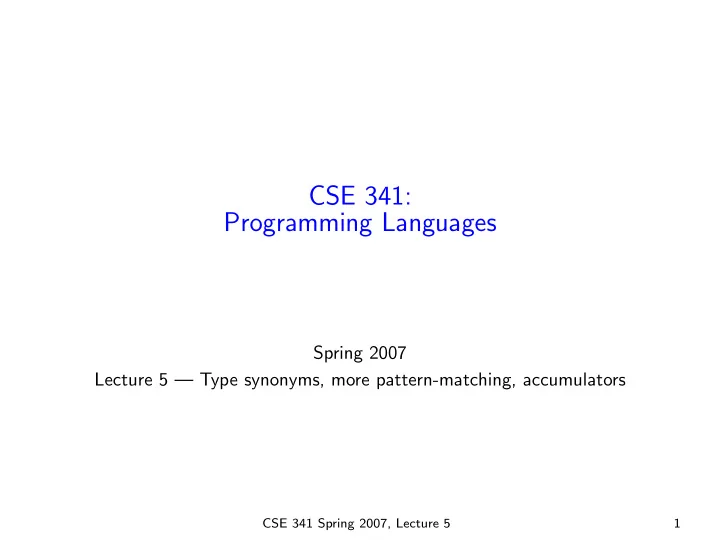

CSE 341: Programming Languages Spring 2007 Lecture 5 — Type synonyms, more pattern-matching, accumulators CSE 341 Spring 2007, Lecture 5 1
Goals • Contrast type synonyms with new types • See pattern-matching for built-in “one of” types (important for ML programming) and “each of” types • Investigate why accumulator-style recursion can be more efficient CSE 341 Spring 2007, Lecture 5 2
Type synonyms You can bind a type name to a type. Example: type intpair = int * int type point = int * int type complex = int * int (We call something else a type variable .) In ML, this creates a synonym , also known as a transparent type definition. Recursion not allowed. So a type name is equivalent to its definition. To contrast, the type a datatype binding introduces is not equivalent to any other type (until possibly a later type binding). CSE 341 Spring 2007, Lecture 5 3
Review: datatypes and pattern-matching Evaluation rules for datatype bindings and case expressions: datatype t = C1 of t1 | C2 of t2 | ... | Cn of tn Adds constructors Ci where Ci v is a value (and Ci has type ti->t ). case e of p1 => e1 | p2 => e2 | ... | pn => en • Evaluate e to v • If pi is the first pattern to match v , then result is evaluation of ei in environment extended by the match. • If C is a constructor of type t1 * ... * tn -> t , then C(x1,...,xn) is a pattern that matches C(v1,...,vn) and the match extends the environment with x1 bound to v1 ... xn to vn . • Coming soon: many more pattern forms. CSE 341 Spring 2007, Lecture 5 4
Why patterns? Even without more pattern forms, this design has advantages over functions for “testing and deconstructing” (e.g., null , hd , and tl ): • easier to check for missing and redundant cases • more concise syntax by combining “test, deconstruct, and bind” • you can easily define testing and deconstructing in terms of pattern-matching In fact, case expressions are the preferred way to test variants and extract values from all ML’s “one-of” types, including predefined ones ( [] and :: just funny syntax). So: Do not use functions hd , tl , null , isSome , valOf Teaser: These functions are useful for passing as values CSE 341 Spring 2007, Lecture 5 5
Tuple/record patterns You can also use patterns to extract fields from tuples and records: pattern {f1=x1, ..., fn=xn} (or (x1,...,xn) ) matches {f1=v1, ..., fn=vn} (or (v1,...,vn) ). For record-patterns, field-order does not matter. This is better style than #1 and #foo , and it means you do not (ever) need to write function-argument types. Instead of a case with one pattern, better style is a pattern directly in a val binding. Next time: “deep” (i.e., nested) patterns. CSE 341 Spring 2007, Lecture 5 6
Recursion You should now have the hang of recursion: • It’s no harder than using a loop (whatever that is) • It’s much easier when you have multiple recursive calls (e.g., with functions over ropes or trees) But there are idioms you should learn for elegance , efficiency , and understandability . Today: using an accumulator . CSE 341 Spring 2007, Lecture 5 7
Accumulator lessons • Accumulators can avoid data-structure copying • Accumulators can reduce the depth of recursive calls that are not tail calls • Key idioms: – Non-accumulator: compute recursive results and combine – Accumulator: use recursive result as new accumulator – The base case becomes the initial accumulator You will use recursion in non-functional languages—this lesson still applies. Let’s investigate the evaluation of to_list_1 and to_list_2 . CSE 341 Spring 2007, Lecture 5 8
Recommend
More recommend